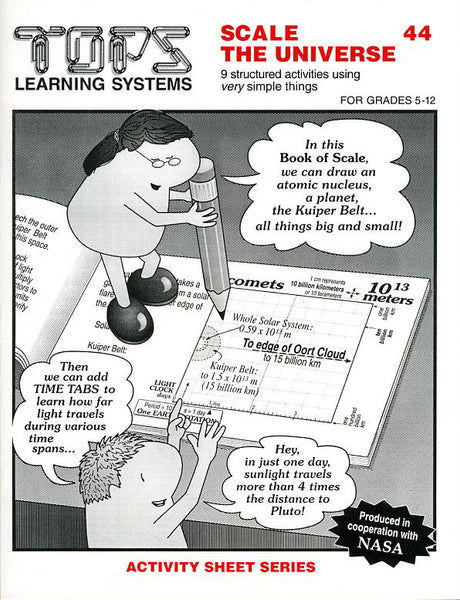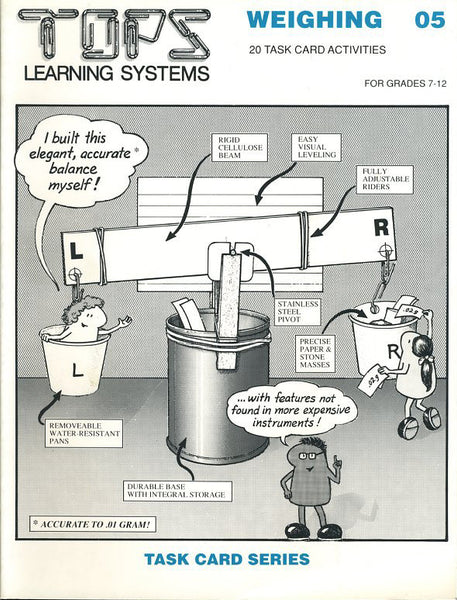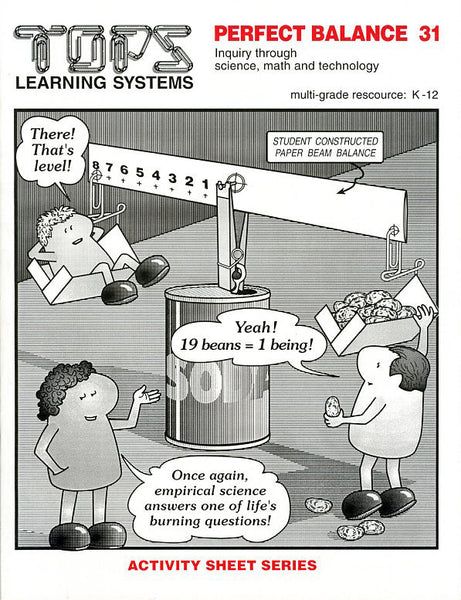#44 Scale the Universe (grades 5-12)
Regular price $23.95
Soft-bound, 64 page book, 9 structured activities, full teaching notes.
Explore distance and time over 40+ orders of magnitude, from protons to the limits of our universe, from a gamma ray period to the lifespan of a red dwarf star. Beginning with familiar human dimensions, flip pages to shrink or expand towards infinity by powers of ten -- plotting, converting, scaling, and drawing in a creative, reproducible Book of Scale. This book is produced in partnership with NASA to inform students about the Fermi Gamma-Ray Space Telescope (formerly called GLAST), launched in June 2008.
More Information – click any of the tabs below to learn more about this title
Click here for a complete list of materials and convenient shopping.
FREQUENT USE
ruled notebook paper
pencils with good erasers
calculators (scientific calculators are a nice option)
* a roll of masking tape
scissors
* rolls of clear tape (or pre-hang strips from students' desks)
* straight pins
soda cans
meter sticks
a stapler
metric desk rulers
* paper clips
* hand lenses (optional)
magnetic compasses (optional)
drawing compasses (optional)
waxed paper (alternative to drawing compass)
a roll of string (nonelastic kite string is ideal)
FREQUENT USE
ruled notebook paper
pencils with good erasers
calculators (scientific calculators are a nice option)
* a roll of masking tape
scissors
* rolls of clear tape (or pre-hang strips from students' desks)
* straight pins
soda cans
meter sticks
a stapler
metric desk rulers
* paper clips
* hand lenses (optional)
magnetic compasses (optional)
drawing compasses (optional)
waxed paper (alternative to drawing compass)
a roll of string (nonelastic kite string is ideal)
Lesson A1: To review metric prefixes, visualize metric distances, and explore decimal relationships on a "meter-tape" graphic that spans 10 orders of magnitude.
Lesson A2: To express equations as unit conversion factors. To use unit analysis in problem solving.
Lesson B1: To qualitatively compare and sort distances, from submicroscopic to astronomic, and plot these on a log scale. To work cooperatively and individually toward a more accurate understanding of how structures in the universe fit together.
Lesson B2: To compare distances by orders of magnitude. To make these comparisons by dividing numbers and by finding the difference between base-10 exponents.
Lesson C1: To construct a Book of Scale with centimeter grids scaled across 44 orders of magnitude, from subnuclear to astronomic. Students begin in the middle of this book by mapping their classroom and drawing themselves.
Lesson C2: To redraw the thumbnail sketches on the Distance Taps to scale in the Book of Scale. To practice drawing circles with a traditional compass, or improvised Circle Tool (optional) as preparation for making these scale drawings.
Lesson C3: To enlarge and reduce scale drawings by powers of ten on adjacent pages in the Book of Scale. To draw important features of the solar system to scale at 5 different orders of magnitude.
Lesson C4: To relate distances across vastly different orders of magnitude to human dimensions and how far we can walk. To develop an overview and kinesthetic sense of distance relationships in the Book of Scale.
Lesson C5: To qualitatively compare and sort time periods that range from nearly instantaneous to billions of years. To tape these time durations on "light clock" scales printed across the bottom of each grid in the Book of Scale. To develop a broad understanding of space, time and scale.
Lesson A2: To express equations as unit conversion factors. To use unit analysis in problem solving.
Lesson B1: To qualitatively compare and sort distances, from submicroscopic to astronomic, and plot these on a log scale. To work cooperatively and individually toward a more accurate understanding of how structures in the universe fit together.
Lesson B2: To compare distances by orders of magnitude. To make these comparisons by dividing numbers and by finding the difference between base-10 exponents.
Lesson C1: To construct a Book of Scale with centimeter grids scaled across 44 orders of magnitude, from subnuclear to astronomic. Students begin in the middle of this book by mapping their classroom and drawing themselves.
Lesson C2: To redraw the thumbnail sketches on the Distance Taps to scale in the Book of Scale. To practice drawing circles with a traditional compass, or improvised Circle Tool (optional) as preparation for making these scale drawings.
Lesson C3: To enlarge and reduce scale drawings by powers of ten on adjacent pages in the Book of Scale. To draw important features of the solar system to scale at 5 different orders of magnitude.
Lesson C4: To relate distances across vastly different orders of magnitude to human dimensions and how far we can walk. To develop an overview and kinesthetic sense of distance relationships in the Book of Scale.
Lesson C5: To qualitatively compare and sort time periods that range from nearly instantaneous to billions of years. To tape these time durations on "light clock" scales printed across the bottom of each grid in the Book of Scale. To develop a broad understanding of space, time and scale.
We encourage improvisation - it's one of the main goals of our hands-on approach! You and your students might invent a simpler, sturdier or more accurate system; might ask a better question; might design a better extension. Hooray for ingenuity! When this occurs, we'd love to hear about it and share it with other educators.
National Science Education Standards (NRC 1996)
Teachers of science...
A: ...plan an inquiry-based science program. (p. 30)
B: ...guide and facilitate learning. (p. 32)
C: ...engage in ongoing assessment of their teaching and of student learning. (p. 37)
D: ...design and manage learning environments that provide students with the time, space, and resources needed for learning science. (p. 43)
• Represent a central event or phenomenon in the natural world.
• Represent a central scientific idea and organizing principle.
• Have rich explanatory power.
• Guide fruitful investigations.
• Apply to situations and contexts common to everyday experiences.
• Can be linked to meaningful learning experiences.
• Are developmentally appropriate for students at the grade level specified.
Core Concepts/Processes: Understand your place in the universe - where you fit into grand scales of space and time. • Draw anything large or small in Books of Scale. Each turn of the page magnifies or reduces scale by a power of ten.
Core Inquiries: Orders of magnitude • Unit analysis • Scaling • Powers of ten • Metric units • Log scales • Scale drawings
Core Content: Learn to think in scale and proportion: If Mt. Everest fit into a tiny pore in my skin: Earth would be as large as a grapefruit; I could walk to the moon in 4 giant steps; I could walk to the Sun in 18 minutes.
TEACHING Standards
These 9 lessons promote excellence in science teaching by these NSES criteria:Teachers of science...
A: ...plan an inquiry-based science program. (p. 30)
B: ...guide and facilitate learning. (p. 32)
C: ...engage in ongoing assessment of their teaching and of student learning. (p. 37)
D: ...design and manage learning environments that provide students with the time, space, and resources needed for learning science. (p. 43)
CONTENT Standards
These 9 lessons contain fundamental content as defined by these NSES guidelines (p. 109).• Represent a central event or phenomenon in the natural world.
• Represent a central scientific idea and organizing principle.
• Have rich explanatory power.
• Guide fruitful investigations.
• Apply to situations and contexts common to everyday experiences.
• Can be linked to meaningful learning experiences.
• Are developmentally appropriate for students at the grade level specified.
Unifying Concepts and Processes
NSES Framework: Systems, order, and organization • Evidence, models and explanation • Constancy, change, and measurement • Evolution and equilibrium • Form and functionCore Concepts/Processes: Understand your place in the universe - where you fit into grand scales of space and time. • Draw anything large or small in Books of Scale. Each turn of the page magnifies or reduces scale by a power of ten.
Science as Inquiry (content standard A)
NSES Framework: Identify questions that can be answered through scientific investigations. • Design and conduct a scientific investigation. • Use appropriate tools and techniques to gather, analyze, and interpret data. • Develop descriptions, explanations, predictions, and models using evidence. • Think critically and logically to connect evidence and explanations. • Recognize and analyze alternative explanations and predictions. • Communicate scientific procedures and explanations. • Use mathematics in all aspects of scientific inquiry.Core Inquiries: Orders of magnitude • Unit analysis • Scaling • Powers of ten • Metric units • Log scales • Scale drawings
Earth and Space Science (content standard D)
NSES Framework: Properties of earth materials • Objects in the sky • Earth in the solar system • Origin and evolution of the universeCore Content: Learn to think in scale and proportion: If Mt. Everest fit into a tiny pore in my skin: Earth would be as large as a grapefruit; I could walk to the moon in 4 giant steps; I could walk to the Sun in 18 minutes.






